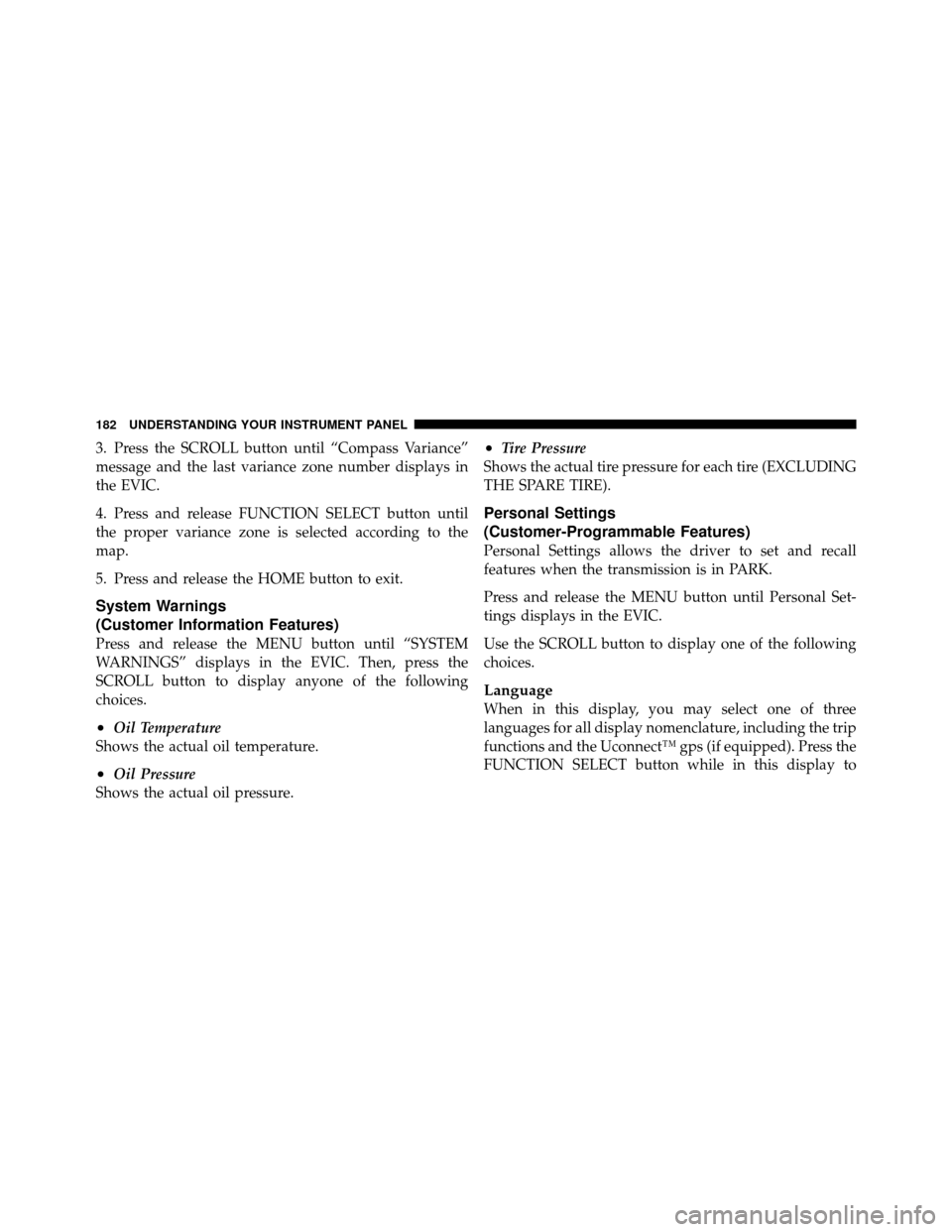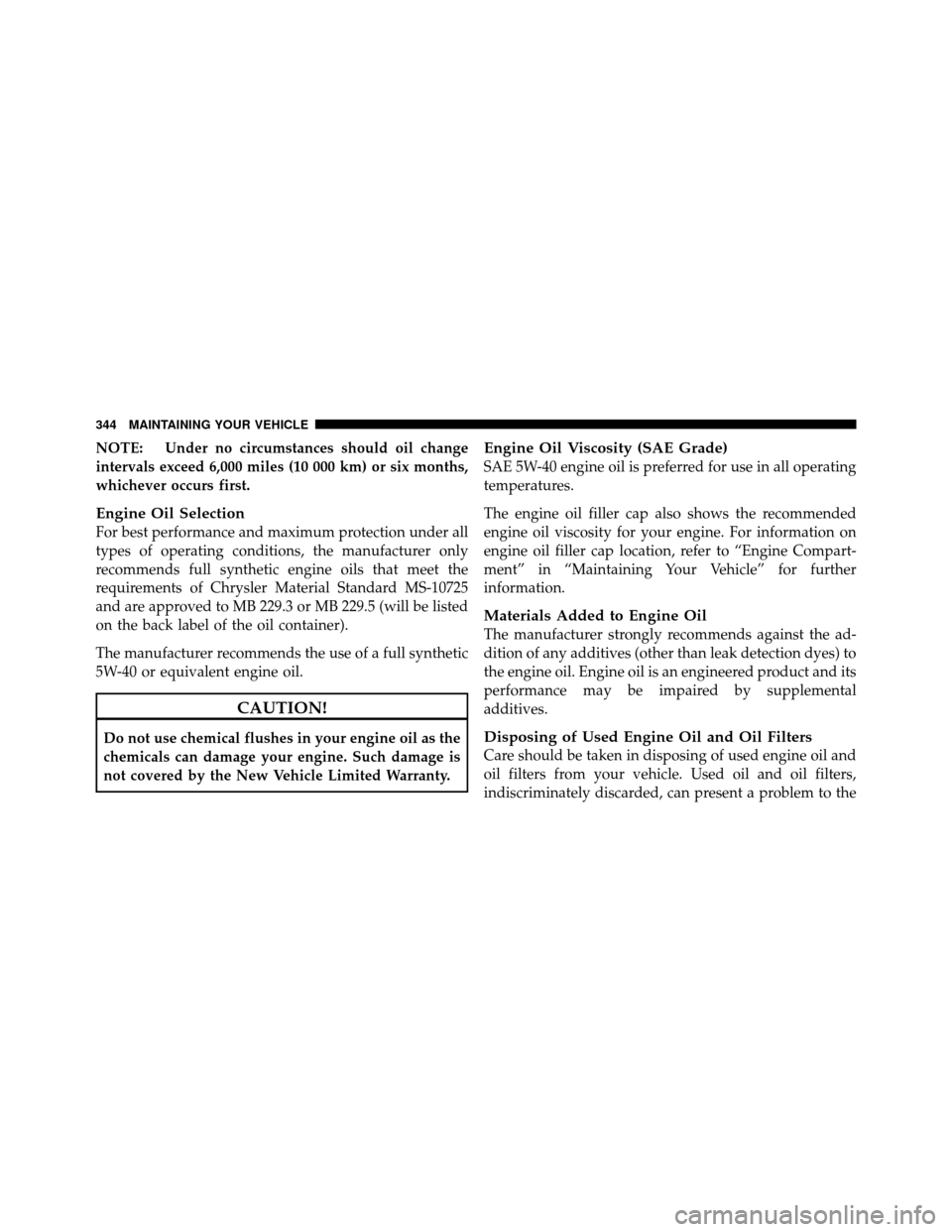2010 DODGE CHALLENGER SRT oil temperature
[x] Cancel search: oil temperaturePage 161 of 436

CAUTION!
Driving with a hot cooling system could damage
your vehicle. If the temperature gauge reads 240°F
(116°C) or greater, pull over and stop the vehicle. Idle
the vehicle with the air conditioner turned off until
the pointer drops back into the normal range 200–
230°F (93–110°C). If the pointer remains at 240°F
(116°C) or greater and you hear a chime, turn the
engine OFF immediately and call for service.
WARNING!
A hot engine cooling system is dangerous. You or
others could be badly burned by steam or boiling
coolant. You may want to call a service center if your
vehicle overheats. If you decide to look under the
hood yourself, refer to “Maintaining Your Vehicle”
and follow the warnings under the Cooling System
Pressure Cap paragraph.
9. Turn Signal Indicators The arrow will flash with the exterior turn signal
when the turn signal lever is operated.
NOTE:
•A continuous chime will sound if the vehicle is driven
more than 1 mile (1.6 km) with either turn signal on.
•Check for an inoperative outside light bulb if either
indicator flashes at a rapid rate.
160 UNDERSTANDING YOUR INSTRUMENT PANEL
Page 183 of 436

3. Press the SCROLL button until “Compass Variance”
message and the last variance zone number displays in
the EVIC.
4. Press and release FUNCTION SELECT button until
the proper variance zone is selected according to the
map.
5. Press and release the HOME button to exit.
System Warnings
(Customer Information Features)
Press and release the MENU button until “SYSTEM
WARNINGS” displays in the EVIC. Then, press the
SCROLL button to display anyone of the following
choices.
•Oil Temperature
Shows the actual oil temperature.
•Oil Pressure
Shows the actual oil pressure.
•Tire Pressure
Shows the actual tire pressure for each tire (EXCLUDING
THE SPARE TIRE).
Personal Settings
(Customer-Programmable Features)
Personal Settings allows the driver to set and recall
features when the transmission is in PARK.
Press and release the MENU button until Personal Set-
tings displays in the EVIC.
Use the SCROLL button to display one of the following
choices.
Language
When in this display, you may select one of three
languages for all display nomenclature, including the trip
functions and the Uconnect™ gps (if equipped). Press the
FUNCTION SELECT button while in this display to
182 UNDERSTANDING YOUR INSTRUMENT PANEL
Page 253 of 436

Over-Temperature Mode
The transmission electronics constantly monitor the trans-
mission oil temperature. If the transmission exceeds nor-
mal operating temperature, the transmission will change
the way it shifts to help control the condition. This may
result in a slightly different feeling or response during
normal operation in DRIVE position. After the transmis-
sion cools down, it will return to normal operation.
Key Ignition Park Interlock
This vehicle is equipped with a Key Ignition Park Inter-
lock which requires the shift lever to be placed in PARK
prior to rotating the key fob to the LOCK position. The
key fob can only be removed from the ignition when the
ignition is in the LOCK position and once removed the
shift lever is locked in PARK.
Brake/Transmission Shift Interlock System
This vehicle is equipped with a Brake Transmission Shift
Interlock (BTSI) system that holds the shift lever in thePARK position when the ignition switch is in the LOCK
position (OFF position with Keyless Go™). To move the
shift lever out of the PARK position, the ignition switch
must be turned to any other ignition position (ACC,
ON/RUN or START) whether the engine is running or
not, and the brake pedal must be pressed.
Brake/Transmission Interlock Manual Override
There is an override for the BTSI that allows you to move
the shift lever out of the PARK position if an electrical
system malfunction occurs (i.e., dead battery). To access
the override (using a flat-bladed screwdriver), carefully
remove the override cover which is located on the right
of the shift lever.
1. Turn the ignition switch to the ACC or ON position
(RUN position with Keyless Go™) without starting the
engine.
2. Firmly set the parking brake.
252 STARTING AND OPERATING
Page 345 of 436

NOTE: Under no circumstances should oil change
intervals exceed 6,000 miles (10 000 km) or six months,
whichever occurs first.
Engine Oil Selection
For best performance and maximum protection under all
types of operating conditions, the manufacturer only
recommends full synthetic engine oils that meet the
requirements of Chrysler Material Standard MS-10725
and are approved to MB 229.3 or MB 229.5 (will be listed
on the back label of the oil container).
The manufacturer recommends the use of a full synthetic
5W-40 or equivalent engine oil.
CAUTION!
Do not use chemical flushes in your engine oil as the
chemicals can damage your engine. Such damage is
not covered by the New Vehicle Limited Warranty.
Engine Oil Viscosity (SAE Grade)
SAE 5W-40 engine oil is preferred for use in all operating
temperatures.
The engine oil filler cap also shows the recommended
engine oil viscosity for your engine. For information on
engine oil filler cap location, refer to “Engine Compart-
ment” in “Maintaining Your Vehicle” for further
information.
Materials Added to Engine Oil
The manufacturer strongly recommends against the ad-
dition of any additives (other than leak detection dyes) to
the engine oil. Engine oil is an engineered product and its
performance may be impaired by supplemental
additives.
Disposing of Used Engine Oil and Oil Filters
Care should be taken in disposing of used engine oil and
oil filters from your vehicle. Used oil and oil filters,
indiscriminately discarded, can present a problem to the
344 MAINTAINING YOUR VEHICLE
Page 351 of 436

Operation of the wipers on dry glass for long periods
may cause deterioration of the wiper blades. Always use
washer fluid when using the wipers to remove salt or dirt
from a dry windshield.
Avoid using the wiper blades to remove frost or ice from
the windshield. Keep the blade rubber out of contact with
petroleum products such as engine oil, gasoline, etc.
NOTE:Life expectancy of wiper blades varies depend-
ing on geographical area and frequency of use. Poor
performance of blades may be present with chattering,
marks, water lines or wet spots. If any condition is
present please proceed to clean wiper blades with humid
cloth removing any debris that may be affecting its
function.Adding Washer Fluid
The windshield washer fluid reservoir is located in the
front of the engine compartment. Be sure to check the
fluid level in the reservoir at regular intervals. Fill the
reservoir with windshield washer solvent (not radiator
antifreeze) and operate the system for a few seconds to
flush out the residual water.
When refilling the washer fluid reservoir, apply some
washer fluid to a cloth or towel and wipe the wiper
blades clean. This will help blade performance.
To prevent freeze-up of your windshield washer system
in cold weather, select a solution or mixture that meets or
exceeds the temperature range of your climate. This
rating information can be found on most washer fluid
containers.
The fluid reservoir will hold nearly 1 gal (4 l) of washer
fluid when the message “Low Washer Fluid” appears in
the Electronic Vehicle Information Center (EVIC).
350 MAINTAINING YOUR VEHICLE
Page 422 of 436

Oil ...........................343,382,383
Oil Change Interval .................... 343
Oil Filler Cap ......................... 344
Oil Filter ............................ 345
Oil Filter Disposal ..................... 344
Oil Selection ....................... 344,382
Overheating .......................... 316
Starting ............................. 237
Temperature Gauge .................... 159
Engine Oil Viscosity ...................... 344
Enhanced Accident Response Feature .......... 54
Entry System, Illuminated .................. 20
Ethanol ............................... 305
Exhaust Gas Caution ................70,307,351
Exhaust System ....................... 70,351
Exterior Folding Mirrors ................... 78
Exterior Lighting ........................ 123
Exterior Lights .......................... 72 Filler Location Fuel
...................... 308
Filters Air Cleaner .......................... 345
Engine Oil ........................ 345,383
Engine Oil Disposal .................... 344
Flashers Hazard Warning ....................... 316
Turn Signal ...................... 72,126,160
Flash-To-Pass ........................... 127
Flooded Engine Starting ................... 243
Fluid, Brake ........................... 384
Fluid Capacities ......................... 382
Fluid Leaks ............................. 72
Fluid Level Checks Automatic Transmission ................. 361
Brake .............................. 359
Cooling System ....................... 354
Engine Oil ........................... 343
Power Steering ........................ 263
10
INDEX 421
Page 426 of 436

Brake Warning..................... 164,267
Bulb Replacement ................... 376,377
Center Mounted Stop ................... 381
Courtesy/Reading ................... 128,137
Cruise .............................. 158
Daytime Running ...................... 125
Dimmer Switch, Headlight .............126,127
Electronic Stability Program (ESP) Indicator . . . 279
Electronic Throttle Control Warning ......... 159
Engine Temperature Warning .............. 161
Exterior .............................. 72
Fog ............................. 125,163
Hazard Warning Flasher ................. 316
Headlight Switch ...................... 123
Headlights ........................ 123,377
Headlights On Reminder ................. 125
Headlights On With Wipers ............124,131
High Beam ........................ 127,162
High Beam Indicator .................... 162 High Beam/Low Beam Select
............. 127
Illuminated Entry ....................... 20
Instrument Cluster .................. 123,158
Intensity Control ...................... 129
Interior .......................... 129,137
License ............................. 381
Lights On Reminder .................... 125
Low Fuel ............................ 167
Malfunction Indicator (Check Engine) ........ 168
Map Reading ...................... 128,137
Oil Pressure .......................... 162
Parade Mode (Daytime Brightness) ......... 129
Passing ............................. 127
Reading .......................... 128,137
Seat Belt Reminder ..................... 162
Security Alarm (Theft Alarm) .............. 165
Service ........................... 376,377
Service Engine Soon (Malfunction Indicator) . . . 168
Theft Alarm (Security Alarm) .............. 165
10
INDEX 425